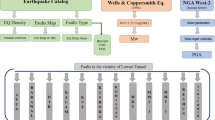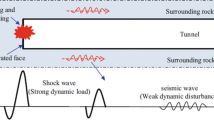Abstract
The second phase of the Chongqing Rail Transit Line project has poor rock and soil stability, slow construction progress, complex and variable geological conditions, and development of groundwater, which seriously threatens the safety of life and property. Therefore, this paper takes this as the engineering background to carry out a simulation research of the electromagnetic response characteristics of the unfavorable geological body under complex geological conditions. The results show that the maximum eddy current is formed in the poor geological body, indicating that the transient electromagnetic method is more sensitive to the low resistance body. The closer the tunnel face, the greater the thickness, and the larger the scale, the stronger the electromagnetic response. The induced electromotive force curve of the B value and the Z axis component of the electromagnetic induction intensity shows that the mutual influence of the two bad geological bodies is small. When there is a low-resistance karst body behind the tunnel face, it will have less impact on the detection of bad geological bodies directly in front of the tunnel face. When the metal body is close to the tunnel face, the detection curve of the induced electromotive force in front of the tunnel face is different from when there is no metal body. When the metal body is more than 30 m away from the tunnel face, the impact on the detection result is limited.



















Similar content being viewed by others
References
Bao SX, Dong BY, Pei YF et al (2020) Application of low temperature TEM to geological exploration in Siziwangqi, Inner Mongolia. J Jilin Univ (Earth Sci Edn) 50(4):1211–1218
Fan T (2020) Coalbed methane fracturing effectiveness test using bore-hole transient electromagnetic method. J China Coal Soc 45(9):3195–3207
Guo JL, Jiang T, Guo H et al (2020) Characteristic of axial anisotropic borehole transient electromagnetic three-component response. J Earth Sci Environ 42(6):1–12
Hu B, Yu JT, Liu ZQ et al (2010) Physical simulation study on low resistive shielding layer of mine transient electromagnetic detecting. Chin J Eng Geophys 7(6):661–666
Hu JH, Li X, Liu H et al (2020) Research on the advanced detection of transient electromagnetic in tunnel construction by TBM. Geophys Geochem Explor 44(5):1183–1189
Lei KX, Xue GQ, Chen WY et al (2020) Relationship between the detection capability and offset of transient electromagnetic method for thin layers. J Earth Sci Environ 42(6):1–6
Li YB (2020) Key technologies for dynamic imaging of disaster-causing concealed water bodies in underground coalmines based on transient electromagnetic method 37(2):399–410
Li X, Wu JJ, Cao DM et al (2006) Advanced geologic forecasting for unfavorable geological body with water—transient electromagnetic method. J Geotech Investig Survey 3:70–75
Li H, Qi ZP, Li X et al (2020a) Numerical modelling analysis of multi-source semi-airborne TEM systems using a TFEM. J Geophys Eng 17(3):399–410
Li SN, Wang XR, Lin T et al (2020b) Numerical simulation of 3D ground penetrating radar based on GprMax for the road cavity. Chin J Geol Hazard Control 31(3):132–138
Liu S, Zeng QN, Zheng ZH (2020b) Application of minimum mean square error algorithm in transient electromagnetic signal denoising. Prog Geophys (in Chinese) 35(5):1826–1831. https://doi.org/10.6038/pg2020DD0255
Liu JP, Yang HY, Jiao JJ et al (2020) Research on layered whole-space response of underground transient electromagnetic method. Prog Geophys 1–13
Luo X, Zhang SY (2016) 2.5-D numerical simulation of transient electromagnetic method based on finite flement. Prog Geophys (in Chinese) 31(1):274–279
Qiu H (2020) Transient electromagnetic wave field transformation imaging technology for coalbed methane enrichment mine goaf. J Chongqing Univ 1–8. https://kns.cnki.net/kcms/detail/50.1044.N.20200828.1433.002.html
Tan DM (2009) Research on theory and application for advanced prediction of water by whole space transient electromagnetism. Southwest Jiaotong University, Chengdu, Doctorial Thesis
Xin HC, Tang JT, Xu ZM (2014) Finite-difference modeling of 2.5-D transient electromagnetic. Prog Geophys 29(5):2278–2286
Zhang YH, Li HJ, Qiu H et al (2019) 3D forward modeling of mine transient electromagnetic by time-domain vector finite element. J China Coal Soc 44(8):2361–2368
Zhou GQ, Yue MX, Yang XD et al (2020) A metal interference correction method of tunnel transient electromagnetic advanced detection. J Geophys Eng 17(3):429–438
Acknowledgements
This research was finally supported by the National "Thirteenth Five-Year Plan" Large-scale Oil and Gas Field and CBM Development Science and Technology Major Project (2016ZX05045).
Author information
Authors and Affiliations
Contributions
Guo Yu and Dongming Zhang conceived and designed the experiments, Guo Yu and Haitao Li analyzed the data and wrote the paper.
Corresponding author
Ethics declarations
Conflicts of interest
The authors declare no conflict of interest.
Additional information
Publisher's Note
Springer Nature remains neutral with regard to jurisdictional claims in published maps and institutional affiliations.
Rights and permissions
About this article
Cite this article
Yu, G., Li, H. & Zhang, D. Simulation Study on Electromagnetic Response Characteristics of Unfavorable Geological Body Under Complex Conditions. Geotech Geol Eng 39, 3371–3382 (2021). https://doi.org/10.1007/s10706-021-01698-y
Received:
Accepted:
Published:
Issue Date:
DOI: https://doi.org/10.1007/s10706-021-01698-y




